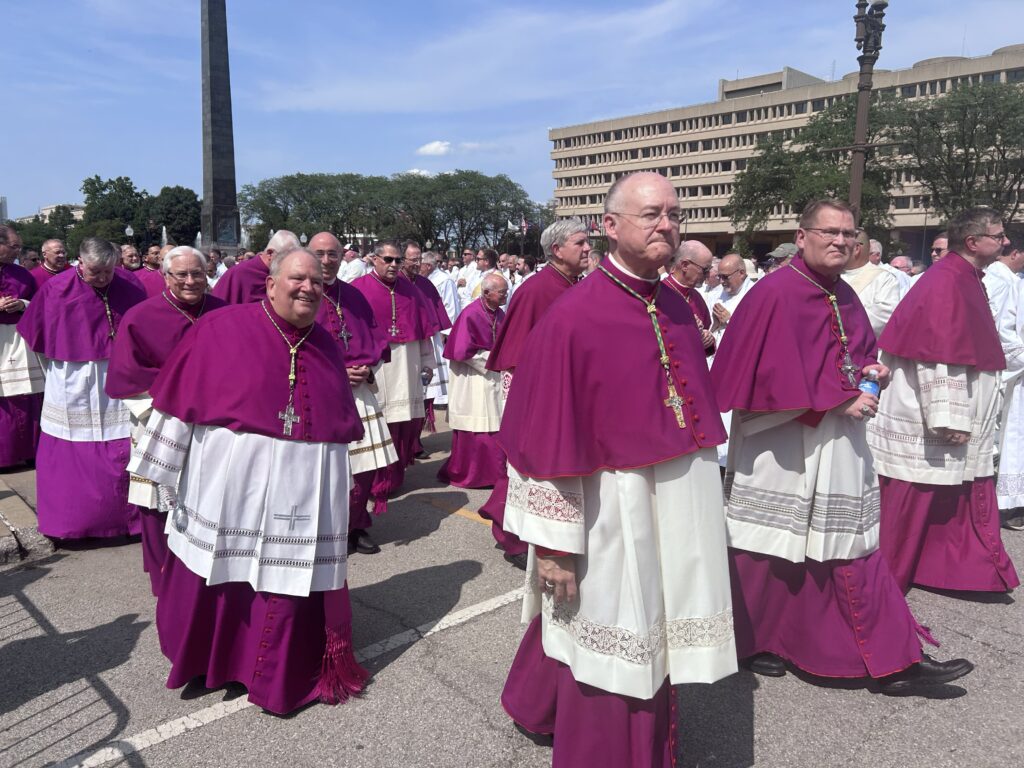
US Bishops Reflect on the Eucharistic Congress: Five Days of 'Wonder, Awe, and Adoration'
By: Our Sunday Visitor

Bishops who attended the National Eucharistic Congress recalled their experiences in interviews after the event’s conclusion in July
(OSV News) — On the first morning of the National Eucharistic Congress in Indianapolis, Milwaukee Archbishop Jerome E. Listecki made his way through the wall-to-wall crowd at the Indianapolis Convention Center, one of the venues of the July 17-21 congress, and saw something remarkable: “Everyone was happy.”
“There was a feeling of kindness toward one another,” he wrote in a July 23 letter to the faithful posted on the archdiocesan website.
“I had the impression that this is the way heaven will be like. The crowd of humanity will be filled with a joyful spirit, people being kind to one another, and all there because of Jesus,” he said. “At His invitation, they would be patiently awaiting directions to the section where they will celebrate life everlasting.”
“Joy” and “joyful,” “kindness,” “respect,” “reverence,” “unity,” “awe” and “wonder” are among the words bishops used in columns, social media posts, podcasts and other commentary after the congress to describe how it unfolded. They spoke of the presence of the Holy Spirit felt throughout the event and the overall atmosphere of the gathering that included lay faithful — including many families — men and women religious, and clergy altogether numbering about 60,000 by the time it ended.
“Throughout the five days of the congress, this joy was palpable — the joy that flows from our faith, from our gratitude for the love of Christ that we experience in our encounter with Him in the sacrament of His love, the Most Holy Eucharist,” Bishop Kevin C. Rhoades of Fort Wayne-South Bend, Indiana, said in a July 23 column in Today’s Catholic, the diocesan news outlet.
“It was truly edifying and uplifting to participate with our brothers and sisters in Christ, bishops, priests, deacons, consecrated religious, families, young and old, faithful of different cultural and ethnic backgrounds, all united in our love of Jesus and His presence with us in the Blessed Sacrament,” Bishop Rhoades said.
He prayed that the congress and the two-month National Eucharistic Pilgrimage that led up to it “will bear much good spiritual fruit for the Church in our diocese and across our nation.”
In this third and final year of the National Eucharistic Revival, the Year of Mission, “we are called to be Eucharistic missionaries in the world,” Bishop Rhoades said. “We are called to live Eucharistic lives — lives transformed by the Eucharistic love of Jesus.”
In one of several video messages from the congress, Cardinal Timothy M. Dolan of New York gave positive marks on the long lines of congress-goers for confession and Eucharistic adoration and for Communion during the Masses.
“People are hungry for the Lord,” he said, adding, “They believe that only he can satisfy the hunger of the heart. That’s what holy Communion is about. That’s what this Eucharistic Congress is about.”
“The National Eucharistic Pilgrimage & Congress were generational events,” said Bishop W. Shawn McKnight of Jefferson City, Missouri, in an Aug. 1 post on X, formerly Twitter. “But as we were reminded in Indianapolis, we must renew ourselves by receiving the Eucharistic Lord at Mass, joyfully following Christ in our daily lives & courageously becoming the saints we’re called to be.”
In a July 29 interview with WXXV-TV, Bishop Louis F. Kihneman III of Biloxi, Mississippi, called the congress a “powerful chance to be in love with Jesus Christ as Roman Catholics and Christians and to share that love with one another. And given all the stuff that’s happening in the United States and the world, it was an opportunity for us to pray for unity and pray for peace in the world especially.”
The bishop shared that his brother bishops “actually came together in prayer the day before we started in Indianapolis and prayed through the success of it” in addition to talking about evangelization “and how to continue to spread the word about Jesus Christ.”
But he also noted that seeing the pilgrims from the four National Eucharistic Pilgrimage routes converge in Lucas Oil Stadium, where about 50,000 faithful were gathered, was “beautiful, striking and deeply moving.”
Encountering “the body of Christ in that capacity, you’re in awe of what he can do and what he does,” Bishop Kihneman said.
“The National Eucharistic Congress was an amazing experience, five days of wonder and awe and adoration,” Archbishop José H. Gomez of Los Angeles wrote in his July 31 “New World of Faith” column in Angelus, his archdiocese’s news outlet.
“The National Eucharistic Revival, launched three years ago by the U.S. bishops, has truly been a work of the Holy Spirit in our times,” he said. “Already we are seeing the revival’s fruits — people coming home to God and coming home to the Church. … There is a great movement of the Spirit going on in our times, a new thirst for holiness and truth, for a love that is pure and beautiful and everlasting.”
He added that the revival has helped people see the Eucharist more clearly as “the secret of God’s plan of love for every soul.” He called on Catholics to help their neighbors “to see that the Love they are looking for is true and real, that this Love is already here, on our altars and in our tabernacles, and that this Love has a name, Jesus Christ!
“Imagine the difference in the world, in our homes, if every Catholic in this country brought just one person back to Mass,” he added.
Bishop James D. Conley of Lincoln, Nebraska, said the congress was “one of the most moving and hopeful experiences” in his 39 years as a Catholic priest. “Time will tell, but I think it will be a moment of extraordinary grace for the Church here in the United States,” he wrote in his July 26 column for the Southern Nebraska Register, Lincoln’s diocesan newspaper.
“Everything seems just a little bit different” after the congress, he said. “The Church, the mystical body of Christ, is on the move here in the United States.”
“The heart of the NEC was, as it should be, the liturgy, which is the source and summit of our faith,” Bishop Conley said, noting the various liturgies at the National Eucharistic Congress “were offered so beautifully.”
But he also pointed out the “fruits of this liturgical source: the talks, praise and worship sessions, works of charity expressed in many forms — including the beautiful accompaniment of the homeless and their needs.”
“Ultimately, everything about the Congress was a reminder that the Blessed Sacrament is a sacrament of charity,” he added. “It is the sacrament that draws us into the life of Christ, who animates our lives so that we may love as He loves.”
Bishop Michael F. Burbidge of Arlington, Virginia, said in the July 24 episode of his “Walk Humbly” podcast that a “massive highlight” of the congress was the July 20 Eucharistic procession through downtown Indianapolis.
“We shut down the city of Indianapolis … and as the Blessed Sacrament is being brought forth, the streets are lined with people every step of the way,” Bishop Burbidge said. At the Indiana War Memorial, the Eucharist was placed atop the steps. The bishops sat on the level below, and below them were tens of thousands of Catholics, who were “quiet, reverent, joyful” as they adored the Eucharist, the Virginia prelate said, adding, “Only the Lord in the Blessed Sacrament could bring us to that silence.”
“The graces we have received” from such “a wonderful, wonderful event” must be shared back home, he emphasized, “or this was all in vain.”
Like Bishop Conley, Bishop Robert E. Barron of Winona-Rochester, Minnesota, said the congress was “one of the greatest moments” in his priesthood of 38 years. It “was splendid beyond words,” he said, noting also “the presence of so many religious and priests in habits and clerical garb” among people there.
The congress was successful, he explained, because “it was predicated upon the supernatural. It exuded the spirit of the supernatural. It ordered us toward the infinitely fascinating world that we cannot see, the world of the angels and saints and the Creator God.”
He said, “At the heart of the entire event was the unnerving mystery of the Eucharist, that Jesus — Body, Blood, Soul, and Divinity — is really present under the forms of bread and wine.”
In a July 23 post on his diocese’s Facebook page, Bishop Donald J. Hying of Madison, Wisconsin, said, “The National Eucharistic Congress reminded me of World Youth Day in Denver” in 1993, which he called “a watershed moment in the life of the Church in the U.S.”
“Many conversions, vocations, and personal apostolates will emerge from the Congress,” he said. “I can’t wait to see what the Holy Spirit is going to do!”

